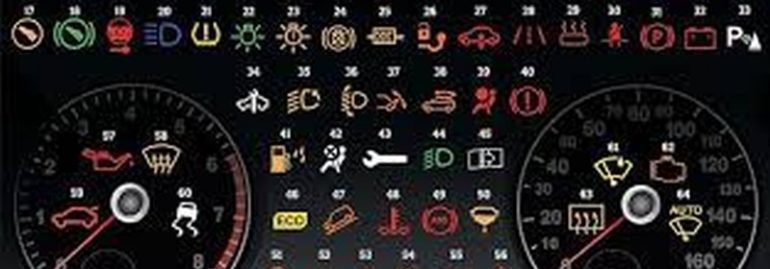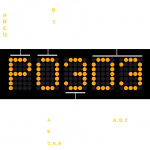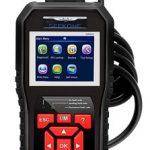When a vehicle starts to malfunction, it turns on the malfunction indicator light (OBDII). However, the codes that are displayed by the system can vary from manufacturer to manufacturer, making it difficult for mechanics to diagnose the issue. This situation changed when the OBDII specification was introduced and made mandatory in 1996. It specifies the type of diagnostic connector, electrical signaling protocols, and messaging format used by cars. Once the standard was implemented, diagnostic tools became very popular.
Diagnostic Trouble Codes (DTCs)
Diagnostic Trouble Codes (DTC) are messages that your car will display when it encounters a particular problem. The system is designed to give you an idea of what’s wrong with your car and what you should do about it. Originally, the trouble codes were grouped into functional areas, such as engine or transmission. However, the latest document has defined these codes more precisely and removed the functional divisions. So, what does each DTC mean?
DTC stands for Diagnostic Trouble Codes, and a vehicle can display different codes. DTCs are generated by the vehicle’s computer when it detects a malfunction in the engine or transmission. The codes are interpreted by a diagnostic scan tool and are available in your vehicle’s owner’s manual. They indicate a problem in your car and can help you pinpoint a solution. A DTC diagnosis will tell you what’s wrong with your car, and you can either replace the part or wait until the problem goes away.
The first digit of a DTC indicates which system is malfunctioning. It can be either a software fault, a hardware problem, or a malfunction in a particular part. Once the mechanic diagnoses the problem, they can correct it with the help of a diagnostic scan tool. The DTCs have a wide range of meaning and can be useful for identifying the cause of a malfunction. But what exactly does a DTC mean?
The device used to read DTC codes plugs into the vehicle’s OBD-II connector. It gives a one-line description of the fault and a description of what the code means. Some of these tools can even be linked to your computer via Bluetooth or Wi-Fi to send the diagnosis to your computer. You can also transfer the diagnostic codes to your phone and computer. If you don’t have a diagnostic scanner, you can download the files using a free software.
Check Engine Light
A Check Engine Light on your car means that something is wrong. It logs diagnostic trouble codes, which provide a starting point for diagnosing the problem. Typically, the code represents a broken part or sensor, a wire or relay, or a lean air-fuel mixture. Sometimes, it indicates a more severe problem. If it keeps flashing, it may be time to take your car to a mechanic.
The Check Engine Light can be a warning of a variety of problems. There are several ways to diagnose the problem, and it’s essential to understand these codes in order to get the necessary repair. These codes are stored in the car’s computer, and can be obtained through your car’s service manual or by purchasing a scan tool online. To learn more about these codes, download the free AutoCodes software. Here are some examples of the codes you can look up:
The code may indicate a problem that has nothing to do with the vehicle’s overall performance. However, it may only point to a general area of malfunction. Further diagnostics are needed to determine the exact cause of the problem. However, some shops may try the wrench-by-numbers method to determine the problem without reading the trouble codes. If you have the proper tool, you will be able to interpret the trouble codes in your car.
The check engine light on a car can mean anything from a loose gas cap to an engine that is seriously misfiring. The latter is a dangerous mistake, as it could cause significant damage to expensive components, and lead to poor fuel economy and increased pollution levels. While the check engine light is a warning signal, it is an essential tool in your car’s on-board diagnostics system. Increasingly, cars are becoming computerized, and they use sophisticated software to regulate engine performance. Check Engine Light car computer codes
OBD2 Scanner
To find the OBD2 port on your car, you must first find the VIN of your car. You can usually find it under the dashboard or on the steering column, but some car models have the port in areas four and nine. Then, you can purchase a hand-held OBD2 scanner, which will give you a list of possible codes. Before buying one, make sure you research the codes you want to check.
A good car code reader will have a large list of the most common car computer codes. The OBD2 scanners will also display the DTC codes that are common in cars. Those codes are called DTCs, and if they are displayed on the screen, it means that the engine is having problems. If you notice a light on your dashboard, you should plug in an OBD2 scanner to find out what the problem is.
For less than $50, you can purchase a hand-held OBD2 scanner. These scanners use a 16-pin trapezoidal connector. Then, you’ll connect it to your car, which requires you to install an app. The OBD2 scanner will display trouble codes on the screen and explain them in plain English. This scanner also uses the data to help you maintain your car. You should also have a professional mechanic install the OBD2 scanner on your car if you want to do it yourself.
If you’re the type of person who enjoys DIY projects, it’s important to invest in a decent OBD2 scanner that includes good customer support. Even the most experienced do-it-yourself-ers might have questions about using a code reader, and the manufacturers of good OBD2 scanners should be able to respond quickly. The same goes for the software updates. Reputable brands will update their software regularly.
Meaning of DTCs
If you’re wondering what a certain car computer code means, read on. DTC (diagnostic trouble codes) are symbols that appear on a vehicle’s dashboard. They represent different malfunctions, such as a faulty engine or transmission. These codes are generated by the power train control module (PTCM) or the engine’s mass air flow sensor. A malfunction in any of these components can result in a DTC. It’s imperative to understand what each DTC code means, especially if the code indicates a serious problem, as it could lead to further damage to the car.
The first two digits of a DTC are generic codes, ranging from 0 to 99. Each digit gives a specific description of the problem. A typical P0219 code indicates a problem with the powertrain. The first digit, 0 represents a generic DTC, while the second digit, 2, describes a problem with the fuel and air metering system. The last two digits, 19 and 20 (corresponding to an overspeed condition), indicate a specific problem within the powertrain.
When a diagnostic code is generated, it’s possible to fix the problem before it’s too late. While the DTC system allows car owners to diagnose vehicle problems before they reach critical levels, it doesn’t always provide the exact cause. For instance, a P030X code is produced when a cylinder fails to fire. However, a vehicle owner may be unable to identify this problem until it’s too late.
Fortunately, there are many ways to interpret the meaning of these computer codes. First of all, DTCs are codes that a car’s on-board diagnostic system generates. They’re a warning that helps car owners understand specific problems. If the codes are too obscure or too long-lasting, it’s best to bring your vehicle to a professional mechanic. The wrong diagnosis could seriously damage the car. And, if it’s too late to fix the problem, you might end up causing even more damage to it.
How to clear them
A check engine light on your car may be a sign of many different problems. A malfunctioning anti-lock brake system, airbags, or automatic transmission may be to blame. It could also be a transmission or emissions issue. No matter what is causing the light, there are ways to clear it quickly and easily. Listed below are some of the steps you should take to get your car back on the road quickly and safely.
To clear trouble codes, you need to drive for 50-70 miles. This is an effective way to reset stored information on sensors monitored by the pcm. Depending on the code, this may take anywhere from 10 to 20 cycles before it is recognized. Once the error is cleared, the computer system can then read other malfunctions without the need to make a repair. Keeping your vehicle well-maintained is essential to maintaining its value and performance.
The data used to store check engine light errors changes as time goes by. Deleting this data from your car’s computer may not be successful for all vehicles, as some modern vehicles store codes even when the battery is disconnected. If you want to successfully clear codes from your car without a scanner, it’s best to do your research first. To do this, look for the negative terminal on your car’s battery. It’s black and sometimes has a minus icon.






